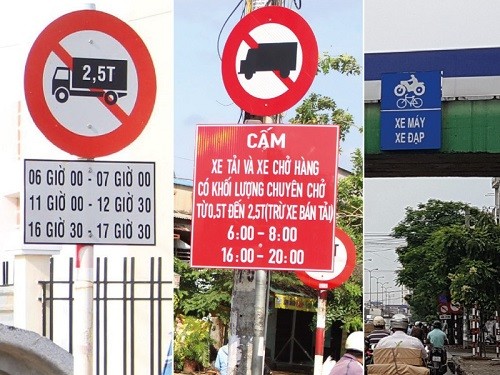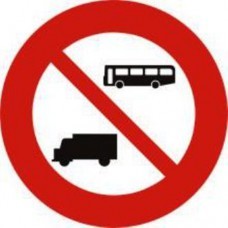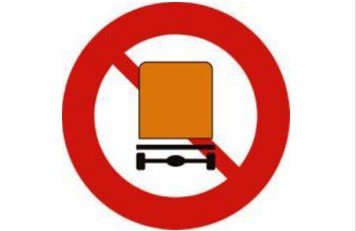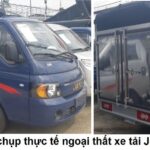For truck drivers, understanding traffic laws is crucial for ensuring safety and avoiding unnecessary legal troubles. Among traffic regulations, clearly understanding the meaning of truck prohibition signs is indispensable. This article from Xe Tải Mỹ Đình will help you understand truck prohibition signs in detail, accurately recognize each type of sign, and grasp their meanings, allowing you to be more confident on every journey.
Common Types of Truck Prohibition Signs
According to the QCVN 41:2019/BGTVT standards, there are 4 types of truck prohibition signs that drivers need to pay special attention to. Each sign carries a distinct meaning, regulating different types of trucks and in various circumstances.
 Various types of truck prohibition signs according to QCVN 41:2019/BGTVT
Various types of truck prohibition signs according to QCVN 41:2019/BGTVT
Truck prohibition signs typically belong to the group of prohibitory signs, characterized by a circular shape, white background, red border, and a black truck symbol inside. Notably, sign P.106c features a distinctive orange hazardous goods truck symbol. The primary purpose of these signs is to regulate traffic flow, reduce congestion, and ensure safety on specific routes.
Detailed Meanings of Each Truck Prohibition Sign
To help you understand truck prohibition signs more clearly, we will delve into the detailed meaning of each type of sign:
Signs P.106a and P.106b: No Trucks Allowed
Sign P.106a is a general no truck sign. It is circular, with a white background, red border, and a red diagonal line from top to bottom, along with a black truck symbol in the center. This sign prohibits all types of trucks, specialized vehicles, and tractor-trailers from traveling on the road section where the sign is posted.
Sign P.106b is similar to P.106a in appearance, but it includes information about the weight limit. For example, the sign may display “2.5t”, “3.5t”, or “5t”, indicating that trucks exceeding the weight specified on the sign are prohibited.
Previously, sign P.106a was often understood to prohibit trucks over 1.5 tons. However, according to QCVN 41:2019, the definition of a truck has been broadened. Currently, semi-trailer trucks, tractor trucks, and VAN trucks with a load capacity exceeding 950kg are also considered trucks and are subject to the regulations of this sign. This means that when understanding truck prohibition signs P.106a or P.106b, drivers need to clearly identify their vehicle type and weight to comply with regulations.
It is worth noting that 5-seater pickup trucks with a load capacity of less than 1.5 tons are generally not considered trucks and are not prohibited by signs P.106a and P.106b.
 Truck prohibition signs P.106a and P.106b
Truck prohibition signs P.106a and P.106b
Sign P.106c: No Hazardous Material Trucks Allowed
Sign P.106c prohibits trucks carrying hazardous materials. The sign features a symbol of the rear of a truck with a prominent orange cargo container on a white background, red border, and red diagonal line. When understanding truck prohibition sign P.106c, drivers transporting hazardous materials must strictly comply and are not allowed to enter the area with this sign.
Hazardous goods are defined as substances that can harm human health and the environment, including radioactive materials, explosives, flammable substances, toxic chemicals, etc. Prohibiting trucks carrying hazardous materials is intended to ensure community safety and prevent unfortunate incidents that may occur.
 Prohibition sign P.106c for vehicles carrying dangerous goods
Prohibition sign P.106c for vehicles carrying dangerous goods
Sign P.107: No Buses and Trucks Allowed
Sign P.107 prohibits both buses and trucks. This sign depicts a bus and a truck placed side by side, with a red diagonal line dividing them. When understanding truck prohibition sign P.107, drivers need to understand that both buses and trucks are not allowed to enter this road section, except for priority vehicles as stipulated by law. Sign P.107 is often placed in areas with high traffic density or roads unsuitable for both buses and trucks to travel together.
Penalties for Violating Truck Prohibition Signs
Failure to comply with truck prohibition signs can lead to serious consequences, not only in terms of traffic safety but also legally. According to Decree 46/2016/ND-CP and QCVN 41:2016/BGTVT, the penalties for trucks entering prohibited roads are as follows:
- Fine: From 800,000 to 1,200,000 VND.
- Driver’s license suspension: From 1 to 3 months.
For specialized vehicles and tractors violating the rules, the fine ranges from 200,000 to 400,000 VND. If causing a traffic accident, the driver may also have their driver’s license suspended for 2 to 4 months.
CONCLUSION
Through this article, Xe Tải Mỹ Đình hopes you have gained a comprehensive and detailed understanding of the current truck prohibition signs. Understanding truck prohibition signs and their meanings is the responsibility of every driver, especially truck drivers. Always pay attention to observation, understand the rules to participate in traffic safely and effectively.

